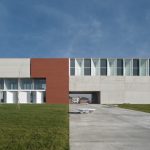
Project: The Health Science Faculty
Project Award: Architecture Award in 2014 from the Chicago Athenaeum of Architecture and Design.
Javier Pérez Herreras (Spain 1967) is a phD in Architecture from the University of Navarre. His research activity, which he develops at different universities, is always related to his professional activity, shared with the architect Javier Quintana at their studio Taller Básico de Arquitectura.
In the methodological route he designs a creative reason matrix: Ideo-Logic: Notebook of equations (2006). As Dean of San Jorge University (2005/09) he develops the implementation of An Academic Itinerary (Illinois 2011) and the design of a new Campus (FAD 2008) which gives room to New spaces for Higher Education (Board of Chancellors of Panama 2007). He was Associate Editor in the International Design Journal, and since 2008 he is member of the Arquitectura journal’s Advisory Board and international advisor for the PLAN 2013 of the School of Architecture of Costa Rica University. He is professor at the University of Zaragoza and visiting professor at IE University.
Taller basico de arquitectura studio is a space for reflection and the proposal of the contemporary, which is ispired by goals such as: excellence as path, research and its parallelism with projects, competitions as the tool for experimentation and theory and teaching as the chance for reality.
The Health Science Faculty, Zaragoza, Spain, 2012 project received the Architecture Award in 2014 from the Chicago Athenaeum of Architecture and Design.
HEALTH SCIENCE FACULTY project will be presented at RIFF Bucharest 2015
The Health Faculty joins the development of that little nature to reinforce the place where the existing buildings rest and where new buildings will do. The new faculty is not only another building; it becomes part of the new place. Architecture is thought as part of a new nature.
The building program is organized in three concave lines. These white and scaled lines unfold on the campus as part of its landscape. Inside, on two floors, classrooms and laboratories are organized for teaching and research. Each scale catches the light needed for each room. The dimensions and shape of rooms allow a big variability of use. Consequently, it is possible an academic reorganization in an easy way. Light coming through scales can be controlled, so digital technologies can be used inside rooms. The minor creases of each line contain the most public rooms of the new faculty: cafeteria, conference room and multipurpose rooms.
The three lines enclose a big room open to the sky. All the access corridors to laboratories and classrooms face this big room. The square gives access to the three lines. Lines look at each other through the square, which discovers the inside of this mineral complex. The inside and outside relation of the faculty gets inverted. The concave outside happens to be the most interior room, and the convex inside becomes the most exterior place.
The mineral nature of this faculty in San Jorge University offers a new landscape of white scales breathing light on the outside, and it offers a big room opened to the sky on the inside.
PHOTO GALLERY



